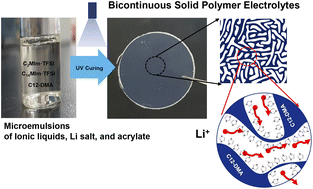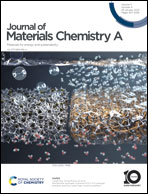Solid polymer electrolytes of ionic liquids via a bicontinuous ion transport channel for lithium metal batteries†
Abstract
Solid polymer electrolytes (SPEs) are a key component of solid-state lithium metal batteries. For attaining high ionic conductivity and high mechanical strength simultaneously, nanostructured SPEs are designed to have functionally separated ion transporting channels and solid-phase walls. Here, we report ion-conductive bicontinuous solid polymer electrolytes (Bi-SPEs) from thermodynamically stable bicontinuous microemulsions of ionic liquids and diacrylates in the presence of amphiphilic ionic liquids and lithium salt. From stable bicontinuous microemulsions with 10–30 wt% amphiphilic ionic liquids, free-standing Bi-SPE films were successfully obtained by photopolymerization and then implemented in lithium metal batteries. At 10 wt% of amphiphilic ionic liquids, the ionic conductivity increased up to 1.4 mS cm−1 keeping the mechanical strength at 0.8 MPa. A LiFePO4-paired lithium metal cell exhibits a stable discharge capacity of 121.9 mA h g−1 with 90.3% capacity retention (CE = 99.9%) over 300 cycles at 0.5 C and 30 °C.



 Please wait while we load your content...
Please wait while we load your content...